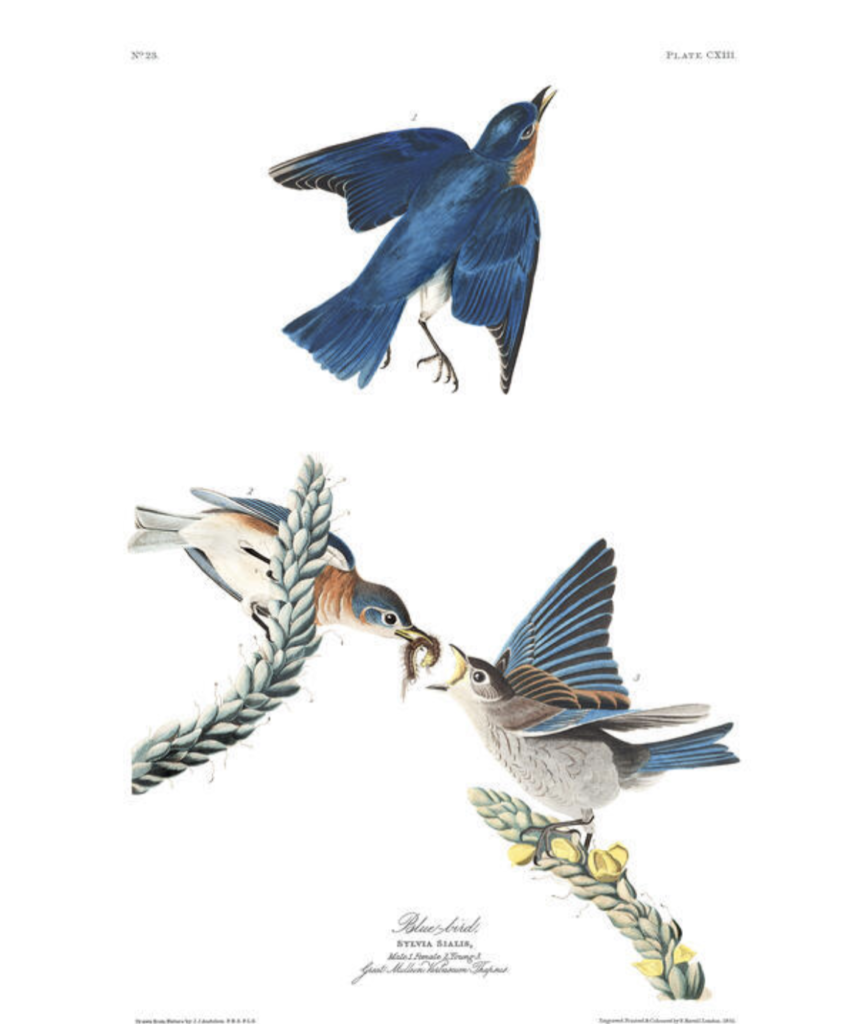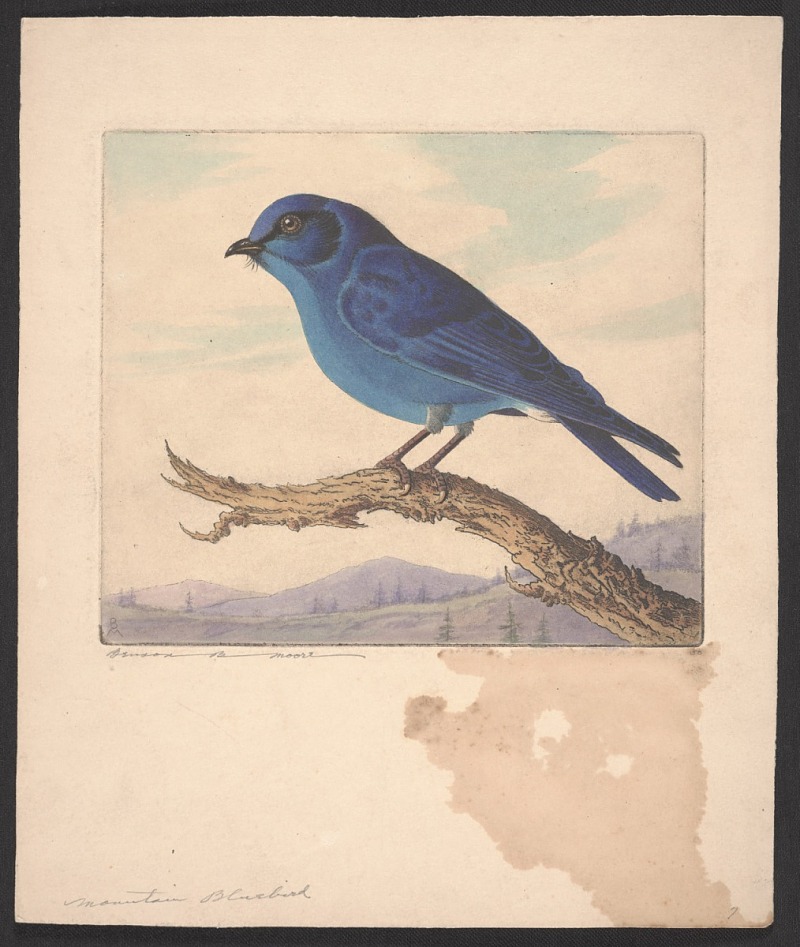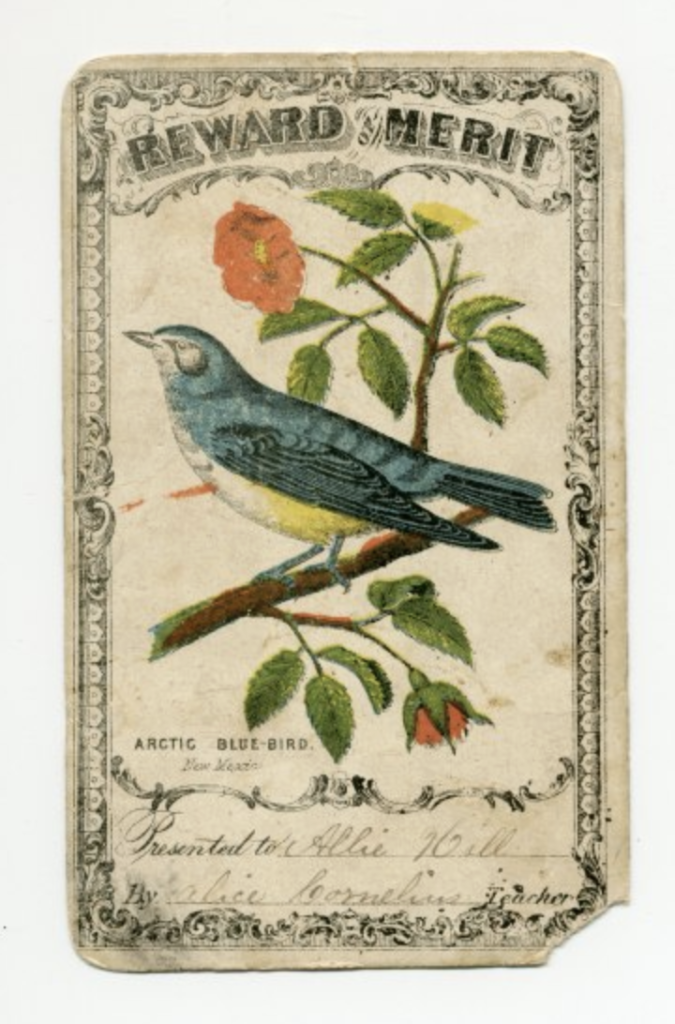Bluebirds in Autumn
By Celia Thaxter
Annotations by Will Smith/KK

The morning was gray and cloudy,
And over the fading land
Autumn was casting the withered leaves
Abroad with a lavish hand.
Sad lay the tawny pastures,
Where the grass was brown and dry;
And the far-off hills were blurred with mist,
Under the sombre sky.
The frost already had fallen,
No bird seemed left to sing;
And I sighed to think of the tempests
Between us and the spring.
But the woodbine yet was scarlet
Where it found a place to cling;
And the old dead weeping-willow
Was draped like a splendid king.
Suddenly out of the heavens,
Like sapphire sparks of light,
A flock of bluebirds swept and lit
In the woodbine garlands bright.
The tree was alive in a moment,
With motion, color, and song;
How gorgeous the flash of their azure wings
The blood-red leaves among!
Beautiful, brilliant creatures!
What sudden delight they brought
Into the pallid morning,
Rebuking my dreary thought!
Only a few days longer,
And they would have flown, to find
The wonderful, vanished summer,
Leaving darkness and cold behind.
O, to flee from the bitter weather,
The winter's buffets and shocks, --
To borrow their strong, light pinions,
And follow their shining flocks!
While they sought for the purple berries,
So eager and bright and glad,
I watched them, dreaming of April,
Ashamed to have been so sad.
And I thought, "Though I cannot follow them,
I can patiently endure,
And make the best of the snow-storms,
And that is something more.
"And when I see them returning,
All heaven to earth they'll bring;
And my joy will be the deeper,
For I shall have earned the spring."

THAXTER, CELIA. “Bluebirds in Autumn.” OUR YOUNG FOLKS: AN ILLUSTRATED MAGAZINE FOR BOYS AND GIRLS 7, No. 84 (December 1871): 726-27.
Contexts
Much like “The Bird in the Rain” by Margaret Mason, this poem uses birds to symbolize optimism in the face of larger adversity. With the recent ending of the Civil War, poems about overcoming seemingly impossible challenges take on additional importance when place within their social context.
Thaxter’s poem resonated beyond the literary world. In 1893, Mary Dana Hicks mentioned it in The Prang Primary Course in Art Education in a section titled “Study of Animals”: “The following poems and songs will aid in interesting the children in caring for the birds” (177). Like Thaxter herself, Hicks participates in a nationwide endeavor to preserve birds in the face of mass slaughter for fashion. Birds–sometimes including the entire animal, with beaks, feet, and all–were especially common on women’s hats. Thaxter rails against this practice in “Woman’s Heartlessness,” an 1887 essay that appeared in the first issue of Audubon Magazine. The prominent children’s magazine St. Nicholas began a movement it called the “Bird Defenders,” which had local societies and activities for children. Teachers might give students a “Reward of Merit” like this one featuring a bluebird.

colorized card, 19th century, Smithsonian Institution.
Resources for Further Study
- Kilcup, Karen L. Fallen Forests: Emotion, Embodiment, and Ethics in American Women’s Environmental Writing, 1781-1924. Athens: University of Georgia Press, 2013. See 205-13.
- Kilcup, Karen L. Stronger, Truer, Bolder: American Children’s Writing, Nature, and the Environment. Athens: University of Georgia Press, 2021. See 246-50, 253-54.
- Mason, Kathy S. “Out of Fashion: Harriet Hemenway and the Audubon Society, 1896-1905,” The Historian 65, no. 1 (Fall 2002): 1-14.
- Slapin, Beverly. “De Colores: The Raza Experience in Books for Children.” Rev. of Celia C. Pérez, Strange Birds: A Field Guide to Ruffling Feathers.
- Vallier, Jane. “The Role of Celia Thaxter in American Literary History: An Overview,” Colby Quarterly 14, no. 4 (December 1981): 238-55.
Contemporary Connections
Cornell University’s Shoals Marine Laboratory has reproduced Celia Thaxter’s garden located on Thaxter’s former home on the Isles of Shoals, off the coast of Portsmouth, New Hampshire. Visitors are welcome through scheduled tours.